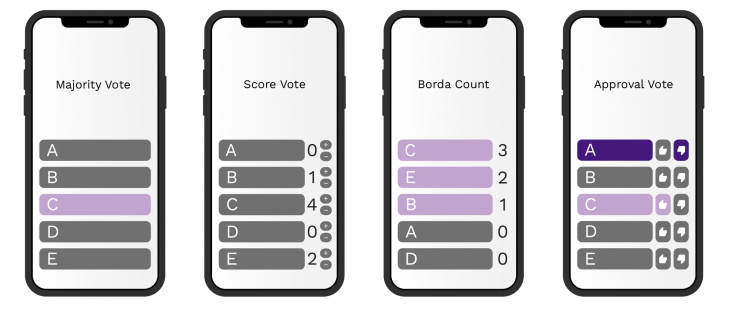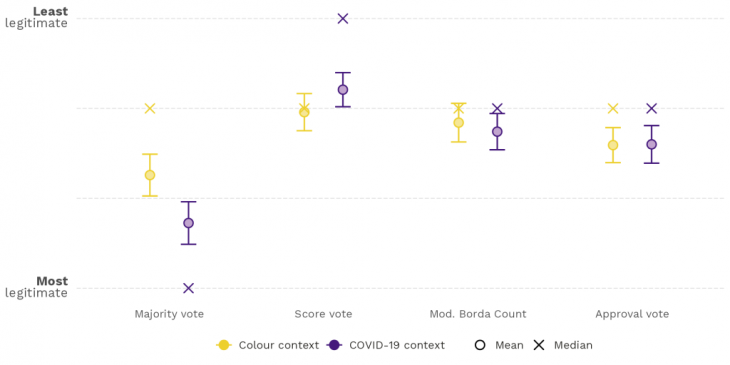Legitimacy is often mentioned as the cornerstone of our democracy. The critical question, then, is how do we maintain this legitimacy that is so essential to the health of our democracy? Our new research has highlighted a key factor: the way in which citizens vote. This seemingly simple act of voting is, in fact, a powerful determinant of how legitimate a decision is perceived by the public.
Majority Voting: Is It the Optimal Way of Decision-Making?
In the world of politics and local community decisions, the majority vote is often seen as the default. We regularly find ourselves voting for a single candidate or one specific community project. However, this raises a crucial question: Is the majority vote always the most effective approach? Could there be other ways to navigate through multiple choices that enhance the legitimacy of the resulting decisions?
To investigate these questions, we conducted an online experiment, inviting participants to articulate their preferences through four different voting methods. Each participant faced a series of questions, each with multiple response options. The participants then had to navigate these choices in four different ways: 1) Selecting a favourite option, 2) Assigning scores, 3) Select and Rank and 4) Approving/disapproving options. The methods were presented in a smartphone app (Figure 1).
Figure 1: Illustration of the four voting methods used for choosing among five options

Figure: Alix d’Agostino, DeFacto
Voters Value Flexibility in Expressing Their Preferences
We found a distinct preference among voters for systems that allow greater flexibility in expressing their choices. Traditional majority voting, which limits the selection to just one option from a set, is perceived as the least flexible method. In contrast, range voting enables a more nuanced expression of preferences, allowing voters to assign up to five points to each option. The Modified Borda Count occupies a middle ground in terms of flexibility, offering more options than approval voting but less than the extensive scale of range voting.
It is exactly this hierarchy of nuance that is also reflected in participants’ perceptions of legitimacy: Range voting is rated as the most legitimate, followed by the Modified Borda Count, approval voting, and, finally, majority voting.
In other words, voters equate the ability to express their preferences in a pretty nuanced manner with legitimacy. However, does this imply that in all collective decision-making contexts, replacing the commonly used majority vote with range voting would yield better outcomes?
Figure 2: Experiment Results: Voting Methods and Legitimacy Ratings

Figure: Alix d’Agostino, DeFacto
Context Impacts Legitimacy: Two Scenarios
To answer this question we applied an interesting tactic: Participants were posed questions of varying significance: some were of substantial political importance, like COVID-19 measures, while others were of minimal societal impact, such as selecting their favourite colour.
What unfolded was rich in insights: The context of the question indeed influenced legitimacy ratings! Regardless of the societal relevance – significant or trivial, participants rated range voting as more legitimate than the majority vote, aligning with our broader findings. However, a more nuanced finding emerged when contrasting these contexts within the same voting method. Figure 2 offers a visual guide to this discovery: When it comes to the majority vote (most left), we observe that in scenarios of lesser societal gravity (indicated by yellow markers), it was perceived as more legitimate compared to contexts with more significant societal implications (purple markers). Strinkingly, range voting demonstrated the reverse pattern. This method received even higher legitimacy in scenarios where the outcomes held significant societal impact.
This suggests that in situations carrying high stakes, voters place greater value on being able to articulate their preferences thoroughly. The ability to rate all options, as opposed to merely selecting a single one, contributed to a heightened sense of legitimacy among voters.
So, what have we uncovered thus far? Voters value flexibility in the voting method, and this preference intensifies in decisions with societal relevance. This insight holds significant implications for policymakers, but there’s more to the story.
The Link Between Clear Preferences and Nuanced Voting
Indeed, policymakers should consider an additional dimension: the correlation between voters’ clarity of opinion and their preferred voting method. During our study, as voters repeatedly evaluated the same set of questions through different voting methods, an interesting pattern emerged: Those with clear opinions tended to view more flexible voting systems as more legitimate. Conversely, voters with fluctuating preferences sometimes misinterpreted their own uncertainty as doubts about the legitimacy of the voting
method itself.
A Roadmap for Policymakers
Based on these findings, a practical recommendation for policymakers emerges. If circumstances permit, why not emulate this study’s approach? Allow voters to engage with the same question multiple times, progressing from straightforward methods like the majority vote to more nuanced ones like score voting. The last method should be the vote that counts. This graduated approach could help voters, especially the undecided ones, to crystallize their preferences without feeling overwhelmed by complex voting systems.
In conclusion, integrating range voting could significantly elevate the perceived legitimacy of decision-making processes, especially in polarized or high-stakes situations. Policymakers aiming to enhance democratic engagement and legitimacy would do well to consider these insights in their electoral design.
Reference:
- Hausladen, Carina Ines; Hänggli, Regula; Helbing, Dirk; Kunz, Renato; Wang, Junling and Pournaras, Evangelos. How Voting Rules Impact Legitimacy (2024). Available at SSRN: https://ssrn.com/abstract=4372245.
image: needpix.com






